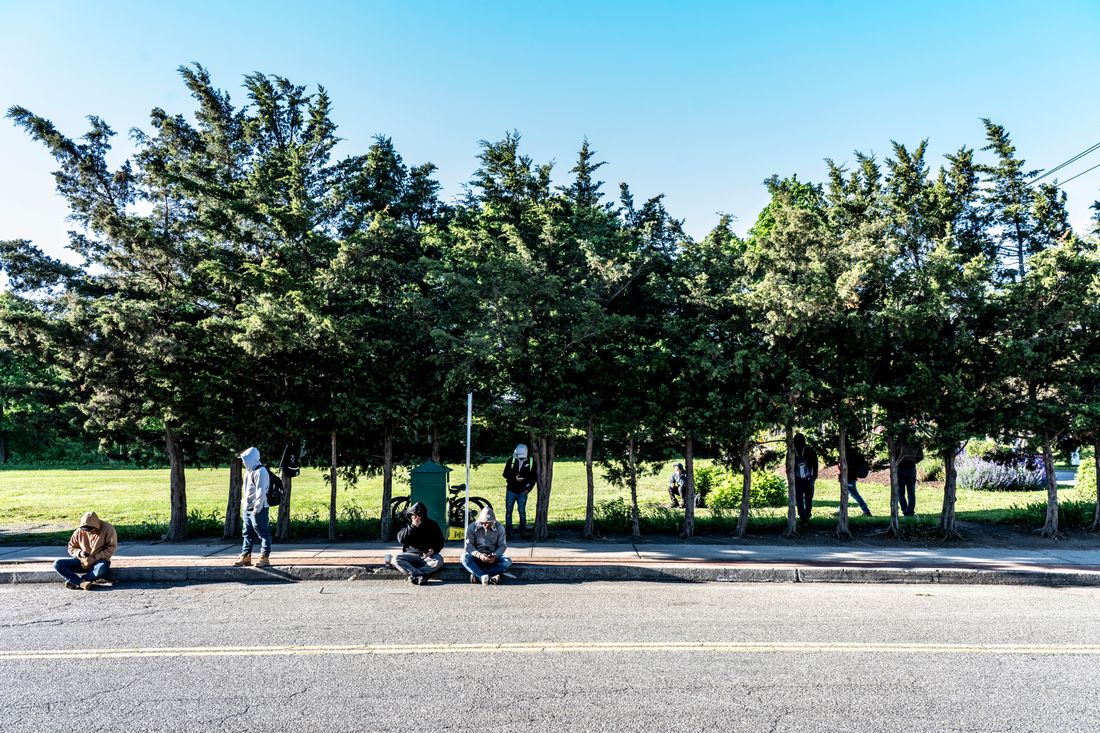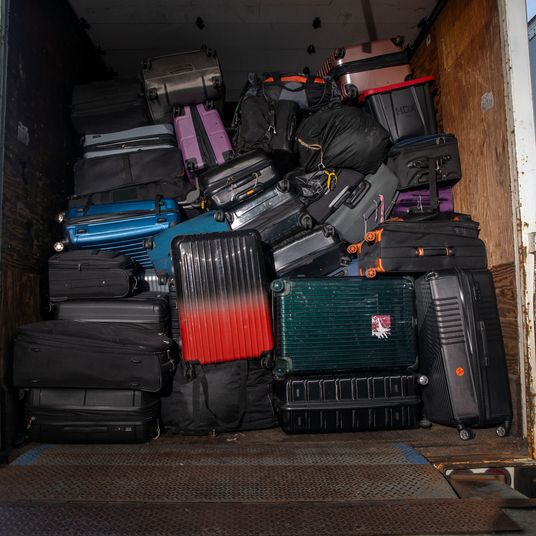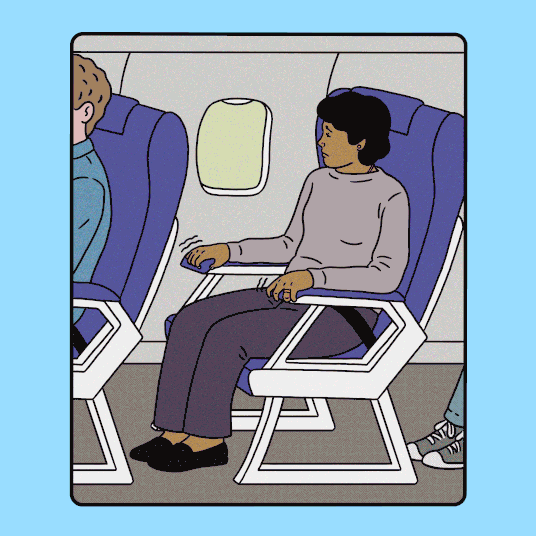
In the spring of 2023, Alejandra became the last of her family to arrive out East. Alejandra’s mother, a housekeeper, and her sister, a server in a restaurant, had been working in the Hamptons for four years since leaving Ecuador; her aunt and uncle for five; their parents and cousins more than 20. She has more family here, she says, than in Ecuador.
Alejandra arrived just in time for the summer boom. The Hamptons was a safe, comfortable place, her family told her, but expensive. Like her mother, she began cleaning houses. She was shocked that, within two days, she was able to find work. The first woman who employed her was exacting, she says, and yelled at the housekeepers to go faster, to reclean areas they had already finished. Alejandra remembered the woman’s face, perpetually twisted in anger. “I almost wanted to go back to Ecuador,” she says, “if that was how I was going to be treated.” (Like many people in this story, Alejandra’s name has been changed to protect her identity.)
But she didn’t go back. She, along with her husband and two sons, found a small rental in Hampton Bays, a more affordable area west of the Hamptons’ ritzier hamlets, which is home to a number of the Latin American immigrants who have become a mainstay of the local workforce. Alejandra’s husband, like her uncle and cousins, took up carpentry. It took them eight months, but they saved up enough to hire a lawyer to file an application for asylum. They enrolled their older son in the local school. They couldn’t afford to go out much, but even the offseason work was regular enough that they felt secure.
In This Issue
For the past few decades, members of the area’s Latino population, some of whom have lived here for years and remain undocumented even as they pursue asylum claims, visas, or other forms of legal status, have maintained an uneasy peace with the rest of the Hamptons. But in the past six months, the onslaught of news — about Immigration and Customs Enforcement raids in workplaces, deportations, arrests of those with green cards — shared in WhatsApp groups and Facebook threads, has created a fear that, as one Colombian woman put it, “seeps into every conversation.” Invitations into homes are reserved for close friends; the presence of strangers sets off muffled alarms. A sense of danger manifests in rumors and in paranoid, if not altogether unlikely, observations. One Peruvian day laborer tells me of a man in an unmarked car he recently saw taking photos of him and other workers as they stood on the corner by a Panera Bread in Hampton Bays. Alejandra gets texts about ICE sightings in and around the Hamptons “almost every day.” Anxieties peaked in mid-June when officers in U.S. Marshals vests were seen swarming a men’s shelter in nearby Riverhead; when local detectives canvassed an East Hampton neighborhood; when police held a routine emergency drill at a Sag Harbor cinema. (None of these was an ICE activity, local authorities later said.)
For years, workers say, the region’s underground economy has subscribed to a “don’t ask, don’t tell” documentation policy. “No one ever asked for papers,” says a housekeeper who came to the Hamptons from Honduras 15 years ago. “What they wanted was experience, recommendations, assurances that you’d do a good job. You were fine if you could provide those things.” Recently, though, she had to leave a job because the house manager asked “nicely but out of nowhere” for a work permit. “I think she was just relaying what the family told her,” she says. Employers in the Hamptons who knowingly hire undocumented workers have always faced the risk of penalty, but she suspects the administration’s warnings of audits and criminal prosecutions have applied new, calculated pressure. Where employers would once perhaps have turned a blind eye to a faulty Social Security number or an expired work permit, they now quietly let people go. (Minerva Perez, executive director of Organización Latino Americana, says the wage theft from undocumented people by employers who assume workers will be too afraid to call the police is also “the highest I’ve ever seen it.”)
Ana, who arrived in the Hamptons from Mexico 20 years ago, tells me she has worked as a gardener, in food service, and, most recently, for a local dry cleaner. She never had an issue keeping a job until a few weeks ago, when her bosses asked her for documentation — the first time in the seven years she had been on their payroll. When she couldn’t provide it, they fired her. Alejandra, who is still waiting to receive her work permit, recently lost two jobs over documentation. “Our work, it’s all we have,” she tells me. She and her husband don’t have savings; they’re in debt to their immigration lawyer. “I’m afraid to go outside, and my kids are asking me every day, ‘What if ICE comes to our school?’” she says. “How do I justify not working?”
Between the 1980s and the early aughts, the Latino population in the Hamptons grew tenfold, and the locals, who already resented the influx of new money, took notice. In East Hampton and Southampton, residents petitioned and complained to the media about the “loitering day laborers” and the new children “overwhelming the local schools.” The tension did little to deter immigrants or those who relied on their labor. The industries that would eventually become the bedrock of the Hamptons economy — service, landscaping, construction — demanded bodies and a lot of them. Across Southampton and East Hampton, Latinos now make up about a quarter of the population; towns like Riverhead, just west of the Hamptons, and Hampton Bays are about one-third Latino. Many local Hamptons schools hovered at 50 percent or 60 percent Latino by 2023. These figures don’t fully account for the number of undocumented people in the area, most of whom, to this point, have gotten by through under-the-table work. As a result, Perez says, there can often be a perception that undocumented people are an inconsequential minority and therefore dispensable. But the reality is, she says, “mixed-status families are everywhere.”
So far, there have been no verified reports of immigration raids anywhere in the Hamptons. The Department of Homeland Security included East Hampton on its list of “sanctuary jurisdictions defying immigration law.” (DHS later removed this list from its website.) Hamptons officials have stressed they do not have the authority to act on behalf of ICE but did say they’re more than willing to work together on “criminal matters,” the definition of which, if left to the administration, could encompass any number of things — especially when what constitutes legal status is in constant flux. In early June, the Trump administration revoked the legal parole status of more than half a million immigrants from Cuba, Haiti, Nicaragua, and Venezuela.
The threat of deportation, coupled with the sense that their ability to work has been indefinitely compromised, has pushed some people to consider leaving. Ana, one of the women fired from her job, is one of them — at 55, her inability to work seems to have unraveled, finally, the promise of a better life. She fears being deported, but, she says, she could have lived with the fear if she were still able to send money home. Sitting on the edge of her bed in the cramped single room she shares with her daughter in a row of dilapidated cabins just outside Southampton, she rubs her eyes at the thought of being detained. “How would I know where they’re taking me?” she says. “I can barely see now, and I never got a formal education. I can’t read. How would I know if they’re taking me back to my village or somewhere else?”
For many, the choice to self-deport comes down to “Do I want to leave on my own terms, with my own clothes and my own money, or do I want to be forced out, arrested, have all my belongings taken, and potentially sent somewhere that isn’t even my country?” says Emilia, who left her native El Salvador almost 15 years ago. For most of her time in this country, she worked as a nanny, but in the past five months, she has been taking fewer of those jobs, preferring instead to sell pupusas and empanadas from the safety of her Southampton home. She has been struggling to pay her rent. Three of her friends, she recalls, have returned to their home countries. The first went back to Mexico about three months ago. A little while later, another friend, this one from Guatemala, left. Then another, from Ecuador. All three said the same thing, she says: “Better to leave than to be taken.”
Alejandra, for her part, is actively trying to save up enough money for her family to return to Ecuador by the end of the year. She’ll miss her mother and sister, she says, but her life here isn’t the one they and the rest of her extended family, most of whom have some form of legal status, are living. These days, she puts off going to the store until she absolutely needs to; she tells her children not to play outside. Alejandra’s biggest fear, she says, is being separated from them. Not only losing them but having them grow up here, without her, “in a place that doesn’t feel theirs.”


























